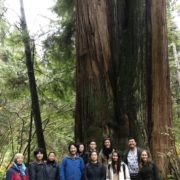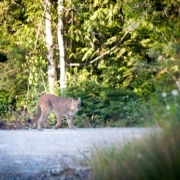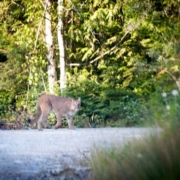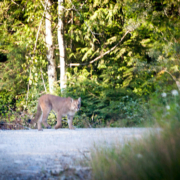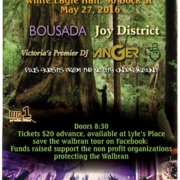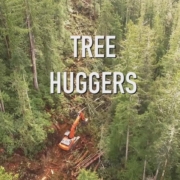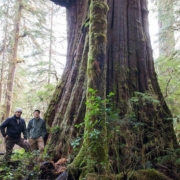Check it out! New Zealand's largest newspaper has an article about the Ancient Forest Alliance, the importance of old-growth forests for the tourism economy of Port Renfrew, and the campaigns to protect old-growth forests including the Central Walbran Valley.
*****
Visitors to British Columbia, on Canada's Pacific southwest coast, will no doubt be expecting to see some of the thick evergreen forests the area is famous for worldwide. And of course you won't have to go far to see such trees. You will no doubt see plenty as you fly down the coast to Vancouver airport. But the majority of these forests are made up of second-generation trees. The massive giants that can live more than 1000 years are now largely gone from Canada's wooded areas.
On Vancouver Island – a 30-minute flight from downtown Vancouver – 75 per cent of the productive old-growth forests have been logged, including 90 per cent of the valley bottoms, where the biggest trees grow. However, as in New Zealand, small pockets of old growth ancient forest remain, and – like this country – people are rallying to ensure they remain protected from loggers and accessible to visitors keen to view Canada's fascinating botanical heritage.
One such man is T J Watt, who, on a wet spring day, met our small group at an area that has become known as Avatar Grove, a 20-minute drive north of the small coastal settlement of Port Renfrew.
“I came across Avatar Grove in 2009 while looking for old-growth forests and giant trees in the Gordon River Valley near Port Renfrew,” says 31-year-old Watt. “The most accessible old-growth trees usually were logged first, so it's surprising this area still exists, given that it's just a few minutes from the road.”
Watt had to move fast if he wanted to protect the area, which was slated for logging in 2010. He and long-time forest activist Ken Wu had recently formed a group called the Ancient Forest Alliance and, with the Port Renfrew Chamber of Commerce, lobbied for its protection – which was granted in early 2012.
The group has since been constructing a boardwalk to protect the grove's ecological integrity, enhance visitor safety and access, and support the local economy of Port Renfrew and the Pacheedaht First Nation people. The boardwalk and accompanying hikers trail is expected to be completed this year.
Asked whether his project was named before or after the popular 2009 science fiction movie, Watt laughs, and says the area needed a catchier name than just the cutblock number.
“The area is largely untouched and with such amazing old giant trees that were in danger of being cut down, the name Avatar seemed to fit well.”
It is hard to deny that fact, as our group walks among the monumental red cedars, hemlocks, amabilis and douglas firs. The next tree we come across is a gnarled giant that would not be out of place on an alien planet. Its trunk resembles the mottled tubes of a pipe organ and is so tall its upper reaches can barely be seen.
Some of the trees are of such magnificent proportions it is easy see why comparisons are often made with the majestic Californian red woods. One tree, known as the San Juan Spruce, is 62.5m tall with a diameter of 3.7m. The world's largest Douglas fir is also in the area. The red creek fir measures 73.8m high with a 4.2m diameter. Watt has started a company called Big Tree Tours and leads guided hikes to Avatar Grove and the other record-sized trees around Port Renfrew.
“My hope is that the Avatar Grove helps to educate the public about the importance of protecting endangered old-growth forests on other parts of Vancouver Island, like the nearby Walbran Valley and how doing so can not only benefit the environment but the local economy as well,” Watt says.
Asked about the substantial contents of his backpack when the trees are barely 10-15 minutes from the road, Watt says it is mostly emergency gear, food, water and first-aid equipment. “In case anyone gets hurt, you never know. Plus, this a wilderness area. You can still get cougars and bears.”
During our group's hour or so in the grove, no such critters cross our path, but to prove his point Watt says he plans to check a nearby “bear-cam” he set up to see if it has had any large furry visitors.
Also joining our group for the day is Toni Chalk, another young Canadian committed to preserving the local forest areas.
Chalk owns Rainforest Tours, a company that takes guided day-hiking excursions to some of the local sites of scenic beauty. Earlier that day she had taken us to the suitably named Mystic Beach – a beautiful and wild spot that was still shrouded in early morning mist on our arrival. Its remote, unspoilt location attracted US draft dodgers in the 1960s but now it is more popular with hikers and surfers.
The 45-minute walk from the carpark takes us through another heavily wooded area, but this time the trees are all second-generation growth, with little that would be more than 100 years old. Not far from the road she stops to point out three massive tree stumps that would easily be a couple of metres across.
“You can see up there the size of some of the trees that loggers took out of this area”, says Chalk, “but thankfully all this is now part of the Juan de Fuca Provincial Park, so what remains will hopefully be here for some time to come.”
The old-growth forests of Vancouver Island are important for sustaining endangered species, climate stability, tourism and clean water, says Chalk. She says many First Nations tribes use naturally falling old-growth red cedars to build canoes, longhouses and other cultural items.
The largest strand of old-growth trees lies just further north of us in a 500ha section of land known as the Central Walbran Valley.
It is for these areas that Port Renfrew has the reputation as the tall tree capital of Canada.
Later that day our group returns for a tasty dinner at the Renfrew Pub, a stone's throw away from the Wild Renfrew – a small eco-resort featuring 11 well-equipped cottages beside the harbour inlet of Snuggery Cove. The cottages are warm and comfortable – exactly what is needed after a damp day's hiking.
After our meal we talk to one of the Pub's owners, Ian Laing, one of four partners who also own the Wild Renfrew resort, The Coastal Cafe, West Coast Trail Lodge and 180ha of surrounding land.
Laing says Port Renfrew used to be solely the domain of loggers and fishermen, but that is changing.
“The whole area is converting from using up primary resources to eco-tourism,” he says, adding that as well as hiking and surfing, the region has some impressive mountain bike trails and a growing kite-surfing community in the harbour.
Read more: https://m.nzherald.co.nz/travel/news/article.cfm?c_id=7&objectid=11708020

